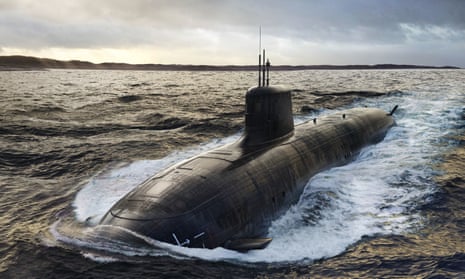The federal government has squirrelled away more than $30bn to lift defence funding over the coming decade, as the Aukus project helps drive spending increases.
Defence funding as a share of the economy is expected to grow from 2.04% now to 2.3% in a decade’s time.
The government has repeatedly said the funding for the nuclear-powered submarines and the defence strategic review will be budget-neutral over the first four years because of other cuts it has made within the portfolio.
Spending announced so far includes $19bn over the coming four years “for nuclear-powered submarines, long-range strike capabilities, strengthened northern bases, workforce growth and retention, innovation, and regional partnerships”.
But overall defence funding as a share of gross domestic product is expected to remain fairly constant over the first four years, with costs ramping up after that point.
The budget papers reveal the government “has included a spending provision in the contingency reserve for increased defence funding over the medium term to implement the defence strategic review”.
Officials confirmed that this additional spending provision was worth $30.5bn between the 2027-28 and 2032-33 financial years.
This will mean defence funding reaches 2.3% of gross domestic product at the end of this 10-year period. The government says this is 0.2% higher than the trajectory Labor inherited from the Coalition.
Sign up for Guardian Australia’s free morning and afternoon email newsletters for your daily news roundup
Key decisions loom when the government prepares a new national defence strategy in 2024. The government has not ruled out further cuts within defence to fund higher priorities.
The defence minister, Richard Marles, said the government had “made no secret that we are willing to make the hard decisions in order to get the best outcome for our ADF”.
Tuesday night’s budget lists Aukus as one of numerous “fiscal risks” the government will need to manage.
The budget does not adjust the long-term estimate that the submarine project will cost between $268bn and $368bn over the period from now to the mid-2050s.
after newsletter promotion
This figure includes $9bn over the first four-year budget period – and between $50bn and $58bn over the first 10 years.
But while Tuesday’s budget includes funding for some initial Aukus costs, officials included a warning about the uncertainty surrounding the complex multi-decade program.
“The total costs associated with the program will not be known until design and production processes are settled and commercial and other arrangements are finalised between governments and delivery partners,” the budget papers warn.
Of initial funding that is certain, the government has earmarked $4.5bn over 10 years “to support the initial steps in Australia’s acquisition of a conventionally-armed, nuclear-powered submarine capability”.
The majority of this – $4.2bn – is to establish and fund the operations of a new Australian submarine agency to manage the overall program.
The government has earmarked $127m over four years for 4,000 additional commonwealth-supported places at universities and other higher education providers “for courses that support the skills requirements of the nuclear-powered submarine program, including STEM and management disciplines”.
At least 800 of these places will be reserved for South Australian universities. The government is promising $11m over three years to extend the defence industry pathways program within the shipbuilding sector of Western Australia.
The Australian Safeguards and Non-Proliferation Office will get $22m in funding over two years “to support the establishment of non-proliferation and safeguard arrangements with the International Atomic Energy Agency”.
There will be $5.2m for the Australian Radioactive Waste Agency “to support the development of radioactive waste management, storage and disposal arrangements”.
The government has decided to provide Australian Naval Infrastructure Pty Ltd with an equity injection “to commence early construction and design works for a submarine construction yard and to design the Skills and Training Academy in South Australia”.
But the government is refusing to break down that amount because of “commercial sensitivities”.
The defence budget also includes an extra $190m over two years to provide assistance to Ukraine fighting the invasion by Russia, about $40m of which relates to measures that are yet to be announced.
